Shilpi Rani Saha1, Arun Kanti Guha2
1Department of Statistics, Jahangirnagar University, Savar, Dhaka, Bangladesh
2Department of Textile Engineering, Southeast University, Tejgaon, Dhaka, Bangladesh
Correspondence to: Shilpi Rani Saha, Department of Statistics, Jahangirnagar University, Savar, Dhaka, Bangladesh.
| Email: |  |
Copyright © 2019 The Author(s). Published by Scientific & Academic Publishing.
This work is licensed under the Creative Commons Attribution International License (CC BY).
http://creativecommons.org/licenses/by/4.0/

Abstract
Social Media is one of the most important source through which people can easily get updated information and they have easy access to online global knowledge bank. Students could utilize the social media as endless source of learning. This kind of stream is suitable for IT learning. The title survey was done on the nature of social media uses by the students of two reputed universities in Bangladesh to clarify the impact on their other daily diverse actions. The information were collected from 502 students on a random basis from both of the universities by providing questionnaire. We have assessed the obtained information through descriptive statistical methods to explain the results. Some important findings in the study show that everyone possesses and uses at least one social media site and many have more than one. They spend more than one hour daily to use social media. Facebook is the most popular among all other social media activity. Students have high positive perception, low negative attitude, and moderate dependency on social media.
Keywords:
Impact, Use, Social media
Cite this paper: Shilpi Rani Saha, Arun Kanti Guha, Impact of Social Media Use of University Students, International Journal of Statistics and Applications, Vol. 9 No. 1, 2019, pp. 36-43. doi: 10.5923/j.statistics.20190901.05.
1. Introduction
Emergence and rapidly change information and communication technology has a significant impact on social networking/ social media. Now just with a press on a button we can see our near and dear one on the screen does not matter where he/she lives [1].The use of social networking sites such as Facebook, Messenger, Imo, WhatsApp and Viber offer youth a portal for entertainment and communication which permits consumers to keep in touch with others and reshaping their daily life. Though there are many positive benefits and impacts of using social medias, the recent Cambridge Analytica scandal has lighten deliberations about our lives for the place of social media and social networking sites [2]. Facebook is popular and its growth has been rapid around the world [3]. As of the first quarter of 2018, the number of Facebook active users worldwide is approximately 2.19 billion (Facebook, 2018).The changes are happening exponentially in recent years. Perhaps, with the expansion of mobile technology it is playing a vital role in restructuring the social networking. Mobile devices have given an easy access in internet regardless anywhere/anytime and how it is dominating in terms of total minutes spent online. This set the resources to connect frequently on various devices in their hands [1].Actually students are fond of social media for many reasons. Firstly, social networks give a feel of freedom to do whatever they want to upload what they want and talk to whom they want. They can make new friends and comment on the posts inbox by them. Social media actually has given students a place where they can create virtual community that may create conflicts in the real world. It gives them the liberty to fascinate themselves with more freedom. It was just impossible just a decade before for young attentions to generate a digital appearance of their activities through such a unprompted medium [4]. The excess usage of social media of people diverted them from watching television and listening radio [5, 6].Researchers are involved in research works on social media how people are being so attached with this day by day. They have been trying to figure out the nature and quality of the activities conducted on social media. There are significant differences between online and offline relationship [7].Now students is the largest user of social media which influencing them to change their daily life, behaviors, community approaches, public life and the bodily events. It has become a immense challenge for the society to address this issue and strongly recommended each member of the society should pay more concern in this substance [8].Facebook, Messenger, Imo, WhatsApp and Viber have rapidly transform ever-present in recent couple of years among all age group particularly young groups mostly maladaptive due to extreme uses [9, 10]. It has been identified following a recent research that excessive browsing of social networking sites (SNS) causes an impact on interactive addiction, categorically 10% of students endorsed a set of requirement habitually thought of as being characteristic of material addiction, including acceptance, or an increase in time spent on the sites, removal, or annoyance or touchiness when incapable to access these websites, and desires for SNS use [11]. Extreme involvement in SNS use has been connected to a different damages in psychosocial activities with loosing tolerances, showing gloomy symptoms, creating problems with interactions, and compact physical movement, lack in the real world community contribution, and decreasing academic success [12-14].Now social media has ignited as a type of online dissertation where people generate content, share it, and bookmark it, and network at a remarkable rate. As a consequence of its ease of use, rapidity and reach, social media is fast shifting the community dissertation in society and locale trends and schedule in topics that range from the situation and politics to technology and the amusement industry [15]. The online world has improved drastically in last one decade, thanks to the creation of social media, young people share ideas, moods and audio visual materials with cheap rate.Martn, (2008) & Lusk, (2010) [16, 17] is aligned with the same perception with social media and according to them social media is the use of Facebook, Blogs, Twitter, My Space and LinkedIn for multi purposes such as communication, sharing photos as well as videos. The widespread use of social networking websites has converted global situation in the last couple of years. What happening out as a hobby for particular computer knowledgeable persons has become a social standard and lifestyle for people from all over the world [18]. Young generation has particularly incorporated these sites as a way to attach with their peers, share material, reinvent their behaviors, and setting their social lives [18].Person to person communication and communication through internet and social networking websites are two completely different platform of sharing ideas and views. Throughout the communication using these websites, they trail instant message (IM) and chatting as well as status or Twitter updates to conversation to friends and direct themselves [19]. Kaitlin (2010) [19] added opines that social networking websites likewise touch the way we obtain information and update. The sites accelerate different portals concluded which we get information and make additional various news openings.The people of Bangladesh are using different kinds of social Media as a platform of communication and sharing their views. The position of Bangladesh is ranked 10th among the top twenty countries with the highest number of internet users according to the research conducted by Internet World Stats. Internet penetration rate as of June, 2017 was 44.5% in Bangladesh [20, 21]. Facebook is the most popular social media in Bangladesh followed by YouTube. According to Bangladesh Telecommunication Regulatory Commission (BTRC), 50% of mobile internet bandwidth and 17% of ISP internet bandwidth are used for Facebook. Dhaka is a city of twenty two million active Facebook users. It is the 2nd highest among all other cities in the world as per survey conducted by Global Digital Statshot. Recent report of Statcounter shows that as of January 2018, Bangladeshhas 93.07 million Facebook users whereas number of YouTube users was 4.93 million [22].73% Facebook user in Bangladesh is within the age range of 13 to 25 while rest is over 25 as per BTRC report. This statistic shows that the parents don’t have clear idea about the usage of Facebook as well as other usage of internet. Because of absence of knowledge about the usage of social media, the parents get panicked and have negative understanding about the impact of social media in education. Networking is connecting individuals in every moment of life all over the world. Around 3.3 billion people, about half of the total population of the world use some form of social media according to a report published in January 2018. As per report a leading newspaper of Bangladesh (The Daily Star) it was state that overall penetration of social media is significant in Bangladesh. Dhaka claims the second leading number of lively Facebook users in the world. Operators are involved in a variety of actions, such as continuing personal linking, receiving news, observing for information, discovery entertainment.This study has been designed to identify on how the excessive use of social media can affect among university student from their personal and social life. The finding of this research hopefully will create an awareness among university students accessing social media. Therefore, the primary reason of this research is to determine the impact of excessive use of social media of Bangladeshi University students.
2. Methodology and Data Source
The method which was adopted for this research was descriptive-comparative research design. The data for it was collected with the help of a survey with a questionnaire. We have collected responses from two universities of Bangladesh for this study. Printed questionnaire was given to the respondents whose are enrolled in the university and requested to fill up the questionnaire instantly. Filled up questionnaire was collected and analyzed later. Percentages and frequency table counts were calculated by using SPSS. Sample size for the research done is 502 which is evenly collected from both the University. The respondents are undergraduate students of those Universities whose age range is between eighteen and twenty five years. To select universities to do the research the convenience-sampling technique was used. Five-point Likert scale, check box, MCQ and dichotomous scales were the tools used in for this study. The questionnaire which was designed distributed consisted of 29 items. The questionnaire had consisted of two parts, Part I – held the respondents’ personal data such as age, gender, semester and department. Part II – was consists of the questions for analyzing the students’ point-of-view regarding the social networking sites. The questions were made on the foundation of readings in apposite thesis, journal articles, and magazines as well as conference with experts. The data was subjected to pictorial analysis, explicitly percentage and frequency table counts, and SPSS was used to analyze the data.
3. Results and Discussion
3.1. Gender Distribution
The starting of the questionnaire was with demographical questions, the gender and the age of the respondents’ were asked. Data was congregate even handed from both sex groups to make the study prototypical. It has been attained as there were 80% male and 19.5% female respondents. We get confirmation from the study that male students were more concerned in with social media than the female students. The comprehensive data are bestowed in Figure 1.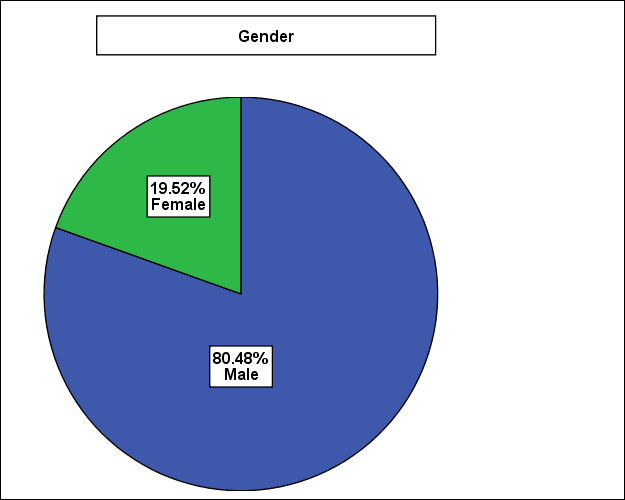 | Figure 1. As per gender wise distribution of students |
3.2. Age Distribution
Age classification of those who were engaged in the survey are from less than 18 year old 1 %t, 18 – 21 years old 52%, 22 – 27 year and above 47%. | Figure 2. Classify Respondents based on Age level |
3.3. Social Media Platform
The following figure will illustrate the depicted delineation of social media individual in Bangladesh. The sample data were found by the survey which was done among 502 students. It shows the behavior of the social networking site users. We have attached here the common social networking sites (SNS) which Bangladeshi people use. From fig 3 we can see that 63.7% use Facebook, 19.5% use YouTube, 9.3% use Instagram and 7.3% use Twitter. | Figure 3. Mostly using social media platform |
3.4. Primary Reason of Social Media Use
After the use of social media students get to express themselves and be joyous by the help of the venues provided by social media. They can be updated on their friends and on the doings of them by simply going to their profile and checking their pictures just in a click of a button. They also get to keep themselves updated with others by posting their pictures for others to observe. In our study an ornamentation on the use of social media by students:Information in Table 1 identify the reasons for utilization of social media by students. The table manifests that most of the users; 45.2% utilize social media for chatting with others. The second is 32.9% for downloading music or video. 16.1% use it for educational purpose. Posting photos 14.7% is also a primary reason for using social media among university students. Some students 13.7% have interest for Blogging in social media. 12.4% use social media for uploading music and video. 9.4% use it for Creating polls or survey purposes. 4.8% use social media for submitting article in the website. 8.2% watch sports news by using social media.Table 1. Primary reason for using social media
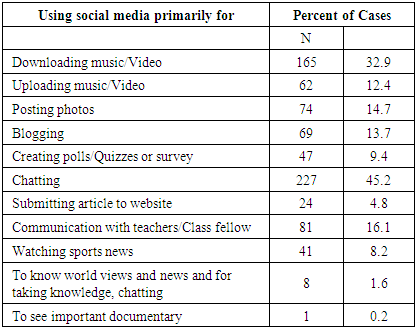 |
| |
|
3.5. Hours Spending on Social Media
Fig 4 illustrates about time spending on social media per day. Time spending on social media meant how long they were logged on the site. 21.5% users use social media 1.5 to 2 hours per day. 16.7% uses 2 to 2.5 hours per day. 11.75% use it for 1 to 1.5 hours. 14.14% use it for ½ to 1 hour. 9.56% use it for 0 to ½ hour. 11.9% use social media for 2.5 to 3 hours. The respondents said that they did not continuously use of SMSs but are live on SMSs during some of this time. Three or more than three hours uses 14.3% users. There are many spiteful users in social media and these accounts are used often. As per studies which have done recently [23] it shows that normal people spend 90 minutes on average in social media daily, which is somewhat more than what our survey deduced, this proposes that, around the globe, people are less vulnerable to social media usage in their daily lives than we currently are. Another possibility is that students of our country have more free time in comparison to others so they can easily manage additional time to browse on social media.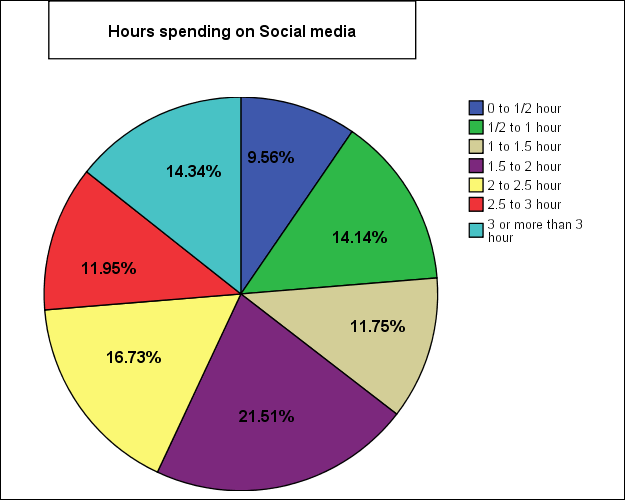 | Figure 4. Hours spending on social media |
3.6. Spend Gigabyte on Mobile Data
The majority of the respondent (44.4%) answered that they use unlimited internet package on their mobile phone. It is also discernible that the value which is the second highest: 2 Gb (11.2%) and it is very close to 3 GB (10.2%). Monthly using pattern of 1 GB and 5 Gb is almost same (6.4%). 4.2% use 10 Gb on a monthly basis. Others user are very close. It is observed that out of the total population half of the total people use additional 2GBeach month, which leads us to the conclusion that there are heavy data users who use the internet in multiple apps for daily activities and necessities such as internet browsing, social networking, gaming and for work. We as well as see that there are still some people who use data for their essential purposes rather than for recreation.The pie chart (Fig.5) shows clearly that how people prefer using WI-FI over mobile data, there are a few reasons for this which are that firstly it is cost-efficient and secondly it has a faster speed and bit rate. Another remarkable feature of using WI-FI is that it is significantly cheaper which leads to the fact that most people use it in their homes, plus there is no added surcharge excluding the monthly installment which most people pay to their ISP/service-provider. People also use free WI-FI at places provides, if possible. | Figure 5. Mobile Data expenditure intensity |
3.7. Prefer to Interact with People on Social Media Rather than Face to Face
According to present study most people believe that interacting with people on social media and social networking sites is basically the same. On networks such as Facebook, Instagram and Twitter, it has become prolific for the fast time for communicating, 45.8% people who responded on the survey say that the interaction time with people on social media and people on reality are the same due to several reasons. 45% said they are more comfortable to interact with people in face to face. And others 9% are unwilling to express their preference.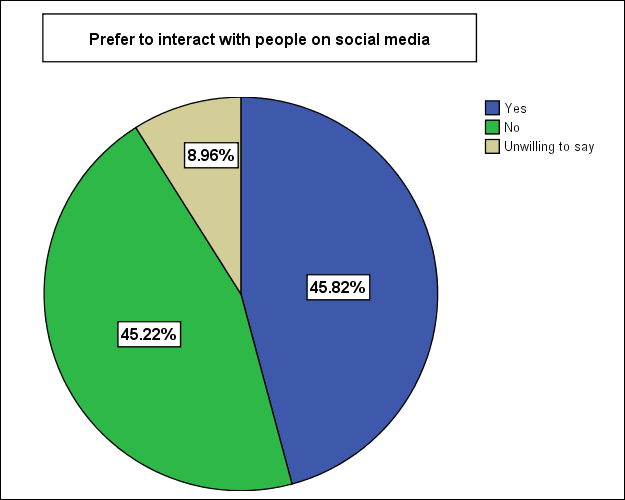 | Figure 6. Like to interact with others in social media sites rather than to go out on the open and interact face to face |
3.8. Effect of Social Media
Nowadays in every one’s life social media have become an inevitable part. Multitude of students in Bangladesh pass a majority of valuable time by speculate about online social media sites. So it is essential to speak briefly the effects of using social media sites on the community. It is observed that (Fig.7) 32.6% university students mentioned social media very much affects them. And 14.7% mentioned that social media does not affect them at all. Others are very close to 25.6% affect them partly and 24.5% does not affect them too much. | Figure 7. Effect of social networking site |
3.9. Students Perception for Using Cell Phones
By the help of the cell phones students now can find venues where they can go and interact with others physically. They can get updated on information about on what others are doing by basically just going to profiles or pictures in a click of a button. Students also post their own pictures online so that others can know about them and what they are doing. Moreover to get real time access from anywhere with the access to the internet many web-based social networking sites have been created such as Facebook and Twitter with mobile applications to be easily accessible around the clock from anywhere. Moreover, many more social networks have been created such as Instagram, to allow groups of people to be built around with the functionality of a mobile.It is discovered that the different patterns of using social media on mobile phone on the daily life of students’ are:Table 2 shows the using behavior of cell phone. Almost half of the students (48.5%) are connected with social media. 32.3% students use Facebook to send message from someone and 21% refresh themselves through Facebook news feed. 38.1% students use phone for watching video in YouTube. About one fourth (25.1%) students use Google in their cell phone. 24.6% students send text someone. 23.2% students keep their mobile phone for all times. 24.4% sleep keeping phone beside them. 29.1% called someone and speak to them over phone. 23.2% students post something on social media. 21.2% respondents claimed that social media is massively responsible for their studies delayed, 9.8% claimed that phone interrupted their conversation or meal. The findings tells us that most of the students’ are sensible and interested in using mobile phone for accessing social media in their daily life.Table 2. Students perception for using cell phone
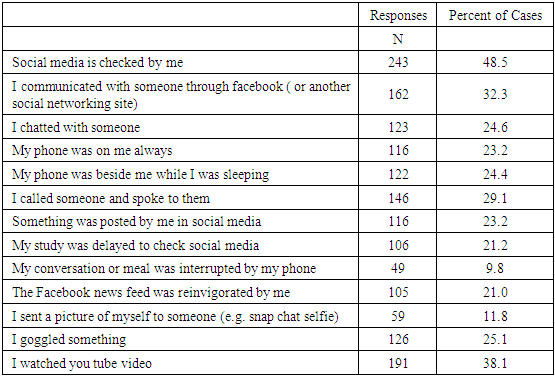 |
| |
|
3.10. Earn Money from Social Media
Social media seems to be growing by leaps and bounds every day. And with it come viable opportunities for individuals and business too. It is shown on research and found out that on average a person spends around two hours on social media but if the person is addicted he probably spends more.Nowadays by the help of social media many people can earn money. The survey data (Fig.8) show that 67.3% never earn money from social media. And 8% answered that they do not know about the process of earning money from social media. On the other hand, 24.7% earned money by using social media. From the study we see that, among students social media is more popular in common use rather than earning money from it.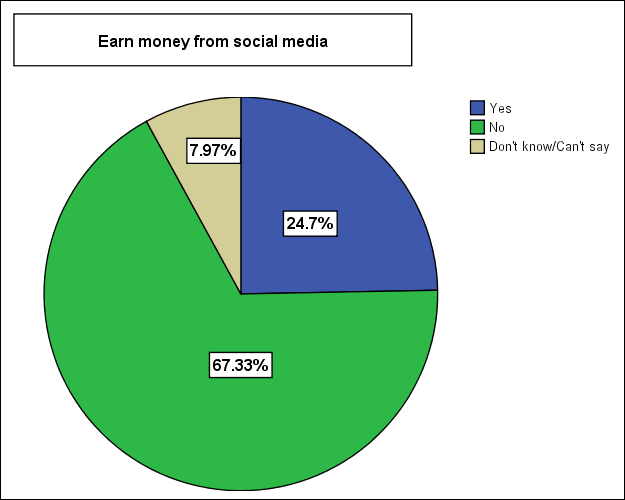 | Figure 8. Earn Money from Social Media |
3.11. Social Media Impact on Student Life
In the data it is shown that students have answered an open ended question about the positive and negative impact on their life for using Social media. Concerning the effect of social media sites, the responses which are obtained from students are shown table 3. The table indicate that majority of the student (37.6%) have no impact in their life for using social media. When the students were responding to query whether they used social media for communicating with each other 17.7% students admitted that they use social media to communicate with each other, 3.0% indicates that social media helps them in various ways. Social media helps them for news update said 7.2%. By using social media 2.4% get help to collect class routine. 2.2% use it to meet their friends. Other impacts are basically the same.Table 3. Impact of social media on student life
 |
| |
|
Concerning the negative effects of the social media students who used it got lesser time to study. Karpinski et al (2009) stated that Facebook users devote lesser time to their studies than the on users did and consequently had poor GPA. Based on this research it has found that most of the students (30.4%) agreed that social media had effect on their studies as they utilized the time for checking on social media rather than studying and this in turn this affected their grades.The reality of this is that most of the respondents from the two Universities accept the fact that social media has a both positive and negative impact on them.
3.12. Social Media Impact on Students’ Health
The increase in the use of social media among the university students motivated them for changing their behavior and habits. Lack of face to face interactions may also lead to loneliness, depression and other mental disorder. The additional time students are involved with social media they are in higher risk of being deprived of their sleep, increment in depression or anxiety and low self-esteem. The effects of them being emotionally unhappy in one site in specific, the more pressure and anxiety may be available always.The study continued to show that 31.3% (From table 4) students are unable to give their opinion whether social media have any health impact. 27.3% agreed that they have any kind of health suffering for excessive use of social media. 25.9% claimed that social media is very responsible eye problem. 8.0% for lack of sleep. 5.0% for headache. 2.4% think that they feel mentally depressed for excessive uses of social media. 2.4% fell stress.Table 4. Health impact for excess using on social media
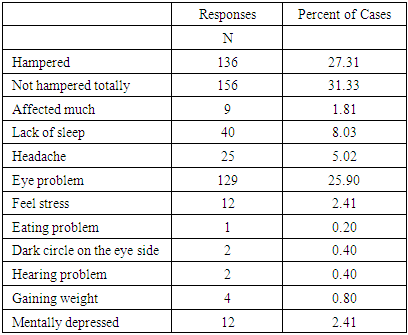 |
| |
|
3.13. Internet Using Devices
Internet facility is not ample in Bangladesh. There is inadequate Wi-Fi connection in most of the universities. There is also restriction in Broadband connection in the university grounds. Greater part of the students used mobile phones (64%) for surfing the internet. On the other hand only 10% used personal computer or laptop for internet surfing. 13% used smart phone and laptop. 7% used smart phone and desktop. 3% used Smart phone, laptop and desktop. 3% used only desktop. We observed that smart phones have begun to be habitual. Comply with the use of personal computers as long as Wi-Fi connectivity in the university hall is proffer by the university authority. The detailed data are presented in Figure 9. | Figure 9. Internet using device of the respondents |
4. Conclusion
Recently there has been a massive evolution in social media, in the way by which people communicate or socialize. From the study we observed that the higher proportion of students accessed to internet through mobile phone leading. Social media is used on daily basis and time span in per day is one hour or higher by most of the students. A significant number of students used social media for chatting. In our findings regarding social media practices by the students Facebook is very popular social media platform among students followed by YouTube and Twitter. Social media is taken as an entertainment task by the students and they prefer to update their status by using social media sites. The majority of the students do not feel any impact of social media on their life. Some of the respondent has positive impact, because social media may be utilize for various communication with others and for news update. Indifferent circumstances, the negative impact of social on student life are that it badly affect their studies and wastes their time a lot.The study also concluded that there is no seriously negative impact of social media on students’ life. If the students’ life has not been affected negatively this will lead to healthy life and consequently might enhance and influence the learning process, occur and meaning will be constructed. The study also recommended the encouragement of students to continue using social media to exchange social issues among them and to form social groups to collaborate on specific issues. The social media should be used such a way that it never hampers education or social lives of students.
References
| [1] | Maryanne Gaitho. July 20, 2018, What Is the Real Impact of Social Media?. https://www.simplilearn.com/real-impact-social-media-article. |
| [2] | Mark D. Griffiths PhD. May 07, 2018, Addicted to Social Media? What can we do about it problematic, excessiveuse?. https://www.psychologytoday.com/us/blog/in-xcess/201805/addicted-social-media. |
| [3] | Vikanda Pornsakulvanich., January–April 2018, Excessive use of Facebook: The influence of self-monitoring and Facebook usage on social support. Volume 39, Issue 1, Pages 116-121. |
| [4] | Abhishek Karadkar, Correspondent, Sep 13, 2015, The impact of social media on student life. http://www.technicianonline.com/opinion/article_d1142b70-5a92-11e5-86b4-cb7c98a6e45f.html. |
| [5] | G. Shabir, YM. Yousef Hameed, G. Safdar. The Impact of Social Media on Youth. A Case Study of Bahawalpur City, Asian Journal of Social Sciences & Humanities Vol. 3(4) November 2014. |
| [6] | S.N. Samsudeen, M. Kaldeen. Adoption of Social Media Marketing By Tourism Product Suppliers: A Study in Eastern Province Of Sri Lanka. European Journal of Business and Management, 448-455. 2015. |
| [7] | Chan D.K.S. & Cheng. G.H. (2004). A Comparison of offline and online friendship qualities at different stages of relationship development. Journal of Social and Personal relationships. 21(3). 305-320. |
| [8] | Aliyar Fathima Nuskiya, Vol. 2 No. 1 2017, The Impact of Social Media among the University Students Empirical Study Based on the South Eastern University of Sri Lanka. Journal of Information Systems & Information Technology (JISIT), ISSN: 2478-0677. |
| [9] | Griffiths M. D., Kuss D. J., Demetrovics Z. (2014). Social networking addiction: An overview of preliminary findings. In Rosenberg K. P., Feder L. C., editors. (Eds.), Behavioral addictions. Criteria, evidence, and treatment (pp. 119–141). New York: Elsevier. |
| [10] | Ryan T, Chester A, Reece J, Xenos SJ Behav Addict. 2014 Sep; 3(3): 133-48. The uses and abuses of Facebook: A review of Facebook addiction. |
| [11] | Hormes JM, Kearns B, Timko CA. Addiction. 2014 Dec; 109(12): 2079-88 Craving Facebook? Behavioral addiction to online social networking and its association with emotion regulation deficits. |
| [12] | Kuss DJ, Griffiths MDInt J Environ Res Public Health. 2011 Sep; 8(9): 3528-52.. Online social networking and addiction--a review of the psychological literature. |
| [13] | Steers M. N., Wickham R. E., Acitelli L. K. (2014). Seeing everyone else’s highlight reels: How Facebook usage is linked to depressive symptoms. Journal of Social and Clinical Psychology, 33, 701–731. |
| [14] | Online social networking in adolescence: patterns of use in six European countries and links with psychosocial functioning. Tsitsika AK, Tzavela EC, Janikian M, Ólafsson K, Iordache A, Schoenmakers TM, Tzavara C, Richardson C, J Adolesc Health. 2014 Jul; 55(1): 141-7. |
| [15] | Asur, S. &. Huberman, B.A. (2010) Predicting the Future with Social Media. Social Computing Lab: HP Labs, Palo Alto, California. pp 1-8. |
| [16] | Lusk, B. (2010) Digital Natives and Social Media Behaviors: An Overview. The Prevention Research, Vol. 17. pp 3–6. |
| [17] | Martin, J.L., & Yeung, K., (2006) Persistence of close personal ties over a 12-year period. Social Networks; 28, pp 331–362. |
| [18] | Boyd, D. (2010) Taken Out of Context: American Teen Sociality in Networked Publics Berkeley, en.wikipedia.org. |
| [19] | Kaitlin, C. (2010) Social Media Changing Social Interactions. Student Journal of Media Literacy Education, Issue 1, Vol. 1. Pp. 1-11. |
| [20] | Internet Top 20 Countries - Internet Users 2017. Retrieved February 13, 2018, from http://www.internetworldstats.com/top20.htm. |
| [21] | Dhaka ranked second in number of active Facebook users. Retrieved February 13, 2018, fromhttps://m.bdnews24.com/en/detail/bangladesh/1319890. |
| [22] | Web Analytics Made Easy. Retrieved February 13, 2018, from http://gs.statcounter.com/social-media-stats/all/bangladesh. |
| [23] | Shortell, T. (2001). An Introduction to Data Analysis & Presentation. World Wide Web: http://academic.brooklyn.cuny.edu/soc/courses/712/chap18.Html. |
| [24] | Information available at www.mobilstatistics.com. |












 Abstract
Abstract Reference
Reference Full-Text PDF
Full-Text PDF Full-text HTML
Full-text HTML


